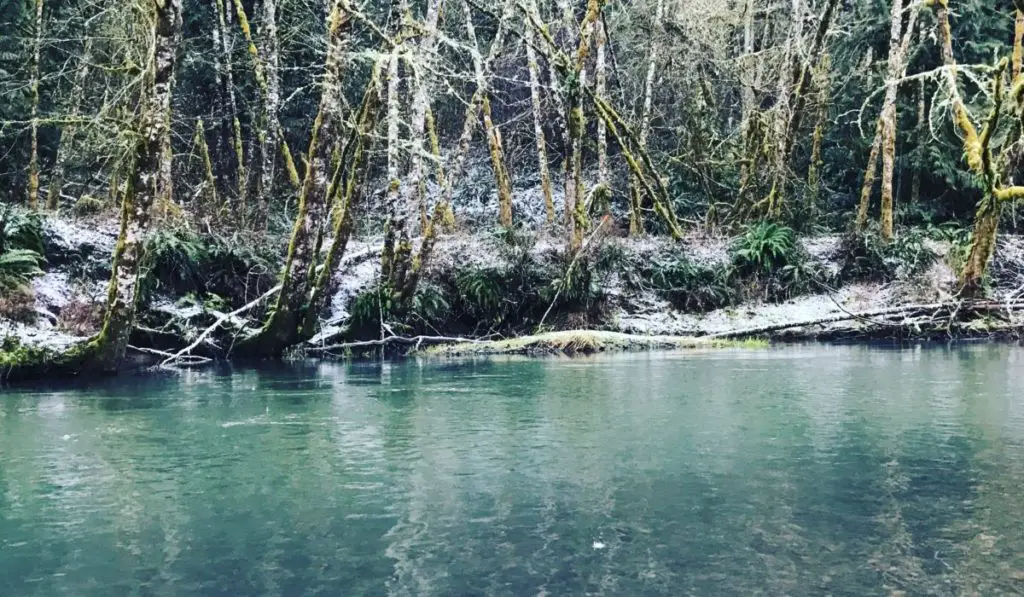
What’s really going on with the Chehalis River winter steelhead season of 2022-2023? Why are recreational anglers being denied access to consume hatchery steelhead and coho which have been raised for the purpose of consumption via the license fees we’ve spent?
Is this all to protect and conserve the vital wild stocks of steelhead whose numbers have dipped precipitously over the last decade and haven’t shown signs of recovery?
Some of the answers may surprise you…
I’ve written quite a bit recently about the Chehalis River steelhead situation this year. There’s still a lot I don’t know about what’s really going on.
However, I do believe we can follow the data and the science to come to some logical conclusions about what’s going on, and perhaps, what if anything we can do about it.
First, you may want to take a look at the coastal steelhead preview piece I wrote back in September, essentially predicting we would be here before anything had been communicated publicly.
You should also read the announcement from WDFW about the modified coastal steelhead season.
So let’s start digging into the data that creates the backdrop of where we are. This is important, because there are nuances to this entire situation that need to be understood.
The outlook for Chehalis wild steelhead is challenging
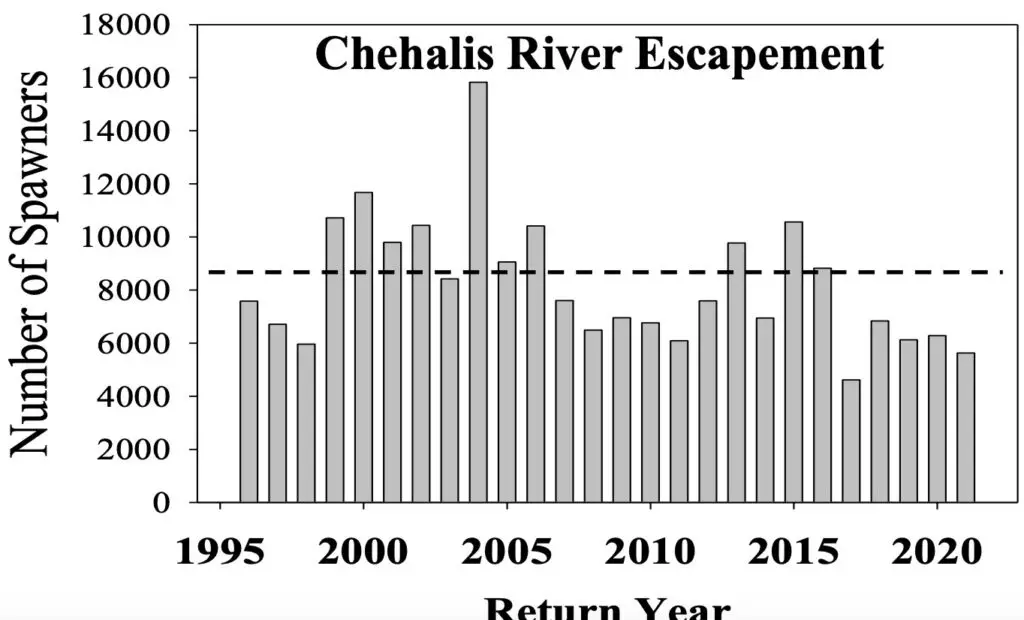
The Chehalis River system has only achieved wild steelhead escapement goals in 10 of the past 26 years. It’s not clear what the escapement was prior to 1996, but from older catch records it’s safe to say they were much healthier.
It’s also safe to say we’ve been in this situation for almost 3 decades!
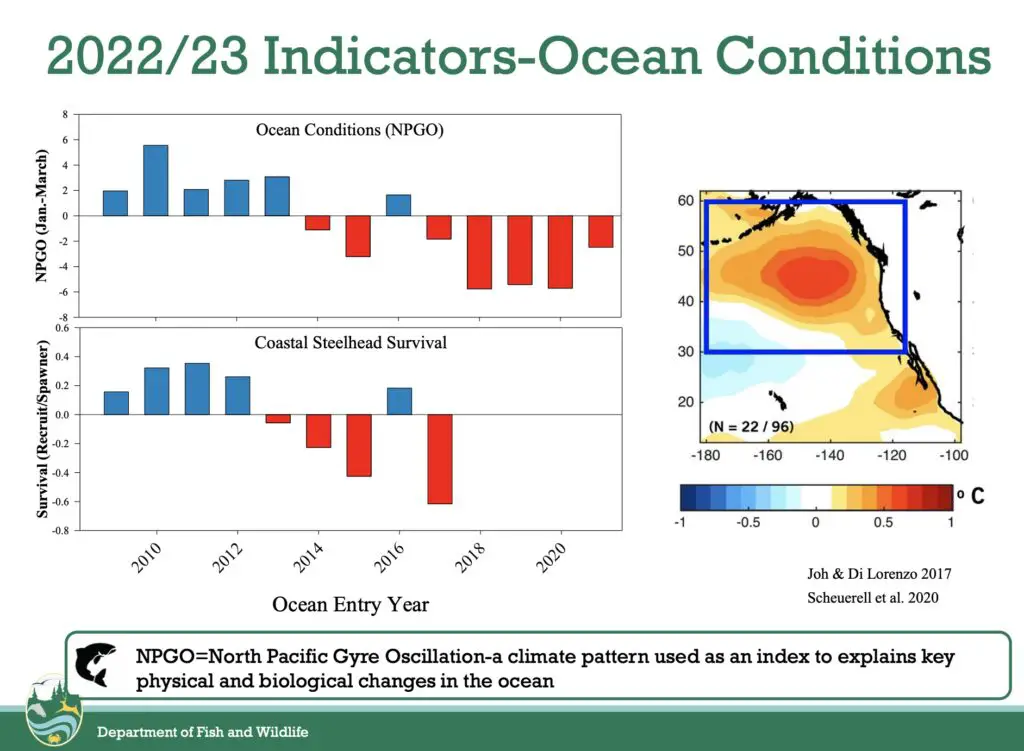
The above slide is pulled from the North of Falcon presentation related to salmon conditions in the ocean, but there’s also a correlation between ocean conditions and steelhead survival as they share the same food web in many ways.
The generally warming ocean of the past 6 years also matches with the lower-than-average Chehalis wild steelhead returns.
But what’s worse, is that while ocean conditions have improved, there is a generally warming trend that makes the events of the past 6 years and the warm water blob event more likely in the future.
So, just because the seasons are closed in 2022-2023 or were closed in 2021-2022, don’t expect an immediate bounce back of wild steelhead on the Chehalis River.
What kind of steelhead fishing opportunity is there on hatchery fish?
So how many hatchery steelhead are returning to Chehalis river system?
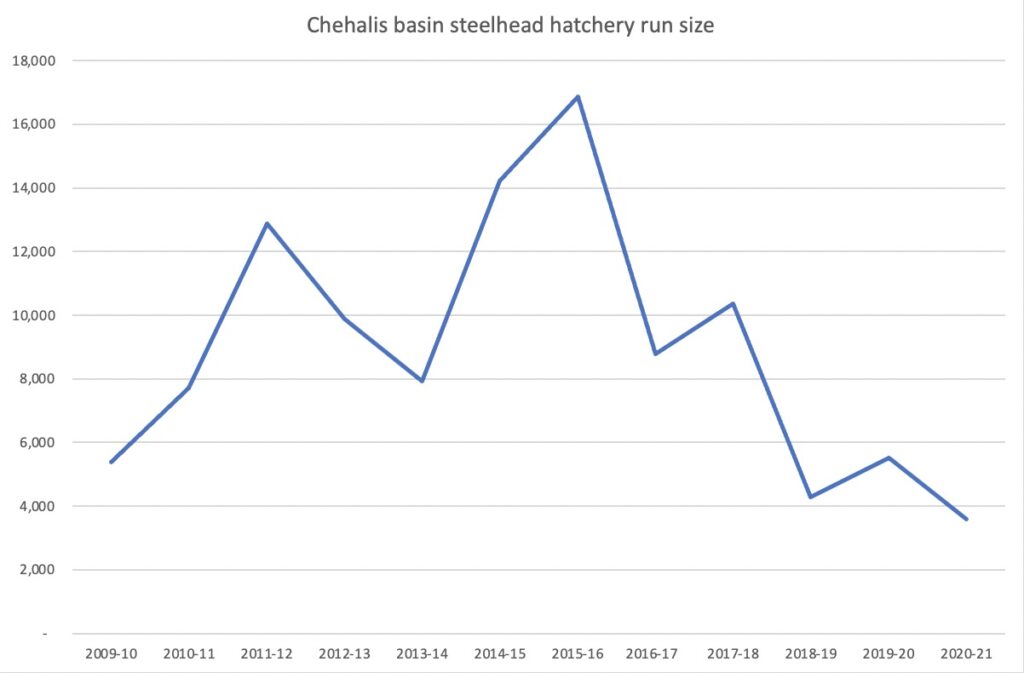
While the hatchery run size has also been impacted by the same conditions as wild steelhead, there’s still a significant amount of hatchery steelhead harvest opportunity.
The Puget Sound Steelhead situation is completely bleak as smolt plants have been reduced and cut back to the point where only a few hundred hatchery steelhead return.
That puts the Chehalis River system as the best opportunity for hatchery steelhead that’s close to where most people live. Without the Chehalis being open, the Pugetropolis steelheaders and many Chehalis Valley locals have no choice but to seek steelhead opportunities elsewhere.
And let’s be honest, a fair number will just not fish for steelhead this winter anywhere.
How much damage will be done to the connection between angler, land, and resources by closing the Chehalis River system 2 years in a row?
Am I suggesting that we should keep a river open at the expense of wild steelhead conservation? Let’s investigate this with data…
How much impact is there on wild steelhead from recreational angling?
Let’s examine to what degree sport anglers impact wild steelhead with all the selective fishing methods in use…
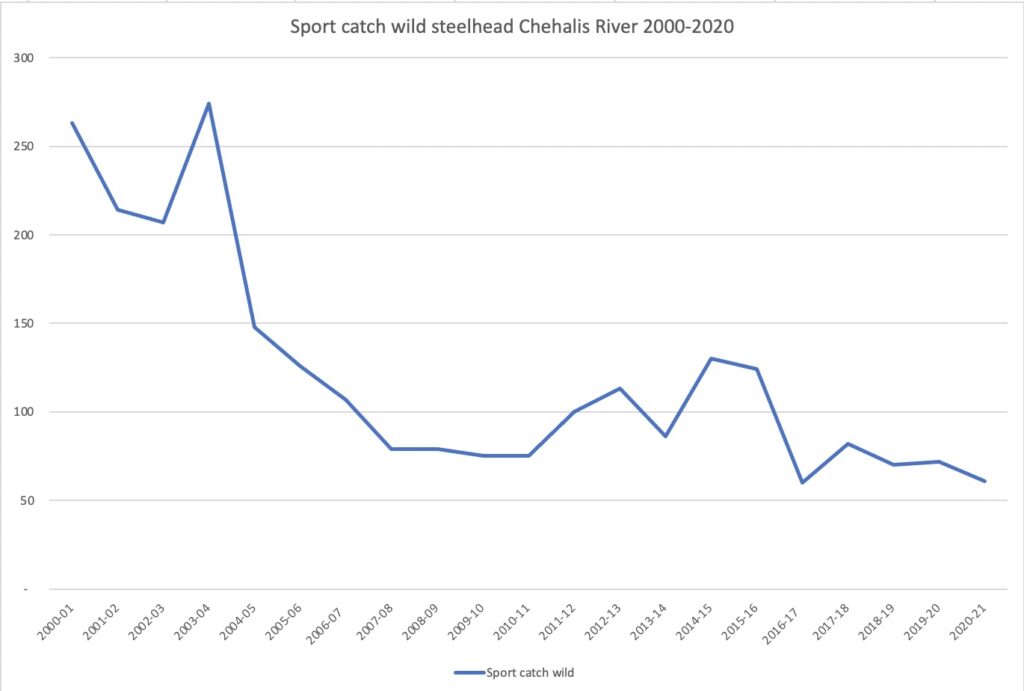
The 2020-2021 season was when the most recent angling opportunity existed on the Chehalis River system and there were 61 wild steelhead caught…and the year prior it was around 70.
The impact from a sport fishing season across the entire Chehalis basin is less than 100 steelhead…that’s around 1% of the total escapement.
If you tell me that we can have an engaged recreational angling community at the cost of 1% of the total escapement of wild steelhead, that seems like a good trade!
But, what if we viewed that number as too high, but we still wanted to create as much opportunity as possible on the Chehalis River?
Let’s consider another scenario:
What other scenarios would allow recreational anglers to access fish on the Chehalis River system?
What if sport anglers fished all of Dec on the lower area of the Chehalis for coho and steelhead?
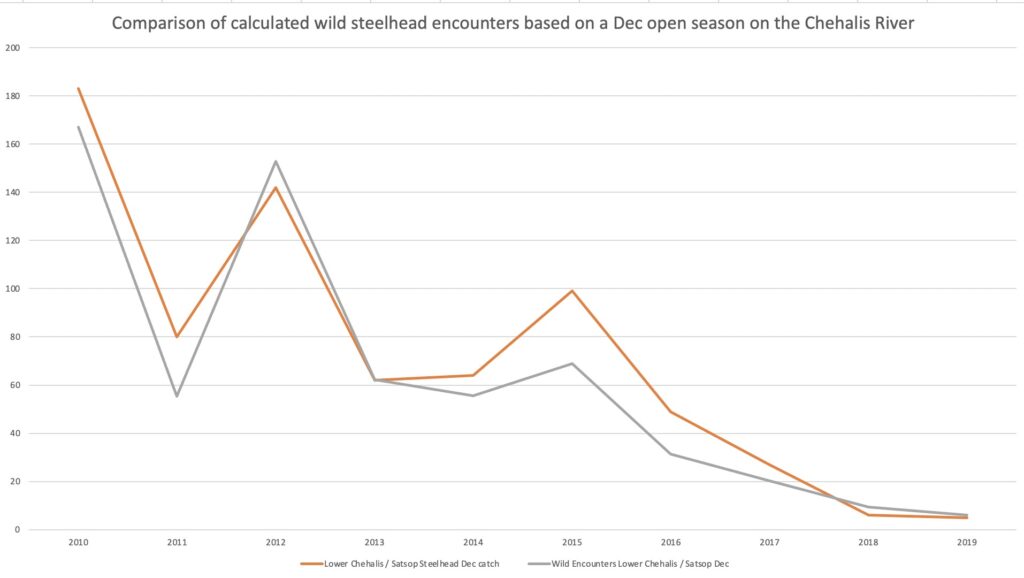
We are talking about a small handful of encounters! Not even mortalities (which are calculated as 10% of encounters)…
So, in the above scenario, the impact is between 0 and 1 wild steelhead mortalities. That seems pretty acceptable, right?
Apparently not, since this scenario is not what the 2022-2023 regulations represent.
Conservation and the sport angler
You may be reading this and thinking I’m coming from the wrong place entirely. As in, I seem to be pro-consumption, even if it risks the goals of conservation. But, that ignores a crucial set of facts about conservation:
Conservation didn’t exist in this country prior to laws which protect wildlife and funding of wildlife management.
That funding comes almost entirely from taxing recreational consumption of the resource.
In other words, conservation is funded by consumption.
Anyone taking aim at consumption is a true threat to conservation.
Yet, that’s exactly what’s playing out in the state of Washington right now. We are undertaking a grand experiment where the system of conservation which has been in place for the past century is being undermined in favor of a conservation without consumption approach.
What about the science?
The data I’m sharing comes straight from these science-backed sources. I didn’t invent it to make my point…I’m following the data.
It’s not the biologists/scientists who are recommending we shut things down on the Chehalis River system…
So why are the seasons that biologists want, not being enacted at WDFW?
So why are the decision makers at WDFW seemingly deciding against science to also hurt the groups who fund conservation?
Let’s explore the possible explanations here…
I worked 20 years in the big corporate world of IT and 15 of those years in a highly competitive big technology company, which provides me with some background experiences to talk about power dynamics within and outside of organizations.
And how decisions get made…There’s always an incentive system at play somewhere…
I can think of two possible scenarios at play here as to why a set of regulations would be crafted to hurt important user groups without any real benefit towards conservation, and in fact, one could argue that will hurt conservation in the long run:
- Tribal groups wanting recreational anglers to not get to fish selectively if there are not enough wild steelhead to fish non-selectively with gill-nets.
- Anti-consumption groups within WDFW looking for any excuse to stop consumption.
Originally, I suspected #1 might be the case, and conveniently it’s what WDFW stated publicly about why the Chehalis River system got the set of regulations it did.
Now, they didn’t actually word it as I have, but the statement was that the tribal groups wanted maximum protection of the resource.
When you dig into the nuances and details though, you can see a different set of regulations such as a December long coho/steelhead season on the Chehalis below Oakville and the Satsop (or perhaps a more hatchery heavy tributary) is still possible while providing maximum protection of the resource.
Not to mention, the tribes surely see the recreational angler as another pro-consumption conservation group just as we see them. That alliance is necessary to counter anti-consumption anti-conservation groups that promote anti-science views of wildlife management and have no broad base of interested constituents who will put their money where their sentiments are with regard to preserving critical wildlife habitat.
There really are only two sides to this issue. There’s pro-conservation consumption and there’s anti-conservation anti-consumption.
Okay, so let’s explore #2 a bit…
Did you know that the governor-appointed WDFW commission is the group that sets wildlife policy and hires and fires the WDFW director?
Sort of like a company board on steroids, since a board typically doesn’t set policy as much as provides fiduciary oversight and can hire/fire the CEO.
Now, why this is important because the past 5 appointments to the commission have all been for anti-consumption anti-conservation members who neither hunt nor fish. This is a 9-member group that sets policy on hunting and fishing, so the majority within the most important group, most responsible for providing sustainable consumption opportunity is now against consumption and is setting policies which choke off conservation funding over the long term…
At the same time, anti-consumption groups like Wild Fish Conservancy, Trout Unlimited, and the like are getting more organized to specifically aim to reform WDFW towards being anti-consumption.
So with that in mind, it stands to reason that some of the folks in lower layers of management would set policy to please these anti-consumption commissioners.
We are about to find out if conservation is still viable while hurting the groups who care the most…
So what can we do about it?
The most important thing we can do is to stay engaged. I don’t know yet where to point people on this topic. I’ve asked this question to people far more connected than I, and I haven’t got great answers.
I do know that the biggest thing that threatens the outcomes we want to see is our own apathy.
There may be a time to throw in the towel and not buy a hunting or fishing license in a given year, but I don’t think it’s that time yet.
And even if we cut off funding to prove a point, don’t we still lose? If we truly believe anti-consumption is anti-conservation, won’t cutting off funding result in irreparable harm to wildlife management? That is the argument after all against anti-consumption groups…
My goal is to increase engagement.
Sometimes you have to stay close enough to an issue as it circles the drain to have the influence at the right moment to affect the outcome.
Keep tabs on this topic, look for opportunities to engage, and boycott companies that fund the anti-conservation groups.
And get out this winter to enjoy the resource we aim to promote and protect. This site is dedicated to highlighting all the opportunities, as others are in this space as well.
I wonder what will become of the s skookum Chuck steelhead now that the steam plant is closing. Will the tribe take that over or will that department of wildlife take it over? What will become of the skookum Chuck steelhead?
They’ve been donating excess to food banks…and they are still planting smolts as far as I know, in hopes of a future season…I’m not holding my breath though.
What can you tell me about the steam plant?
Hello Kyle,
My name is Nic Norbeck.
I have a pretty extensive background on the chehalis and tributaries. I am a full-time fishing guide and have made the chehalis basin my mission in life for the past 25 years. 3 years in a row I did a study with department of fish and wildlife on spring Chinook that has been printed and published. I am not a writer and would not like to be at the center of the circle, however I may have information that would help you write to a further degree about this topic. Feel free to call if you would like.
Nic,
Would love to learn from your work! Let’s start a chat via email: kyle@pnwbestlife.com
Please remember WDFW has to ask the Washington state legislature for a budget from the general fund. So it not just the sportsmen that support WDFW.. The non fishing public supports WDFW too. So you might want to look at which groups are lobbying against a WDFW budget.And you might want to look at the decision makers for coastal steelhead at WDFW. Do they have any connections with the anti – consumption groups? Plus the lack of hatchery production over the last 25 has had a big effect on Steelhead all over the state. Please keep up your investigative reporting. I believe you’re on the right track.
Thanks Greg! Yeah, I feel like I saw the split % somewhere between general fund and license fees…I need to dig that up. And while it’s true WDFW receives supports from the non-user groups, the general public is not connected with or very concerned with important wildlife conservation topics.
I”m definitely going to keep going down this path and looking to get more educated and connected on these topics so I can do a better job unpacking them.
Spot on Greg! The conflicts of interest regarding Preservationist Groups and the Winter Steelhead Commission and Policy Makers is sickening and should not be tolerated. They would be thrown out as Witnesses in any real life court case!….And look at ALL the money, just for example that the Wild Steelhead Coalition alone spent on outfitting Fish & Wildlife Officers last year; it was quite a lot of shiny new toys, ALL aiding in attempting to catch those pesky and harmful
“selective fisherman?!” Give me a break, do new rafts, oars, drones, and rubber ducky water wings for the Wardens equal more Steelhead on the Gravel?…NO
Has anyone done a genetics of both “Wild” & hatchery steelhead? My guess the wild gene pool is diluted enough that we do not have many real Wild steelhead anymore. I sat on both the WDFW Chehalis & Willapa advisory committees at the time HSRG (save the wild fish) was instituted. that was the start of the whole fishign decline. If I remembe rright HSRG was a 50 year plan.. After a numbe r of years, I asked Ron Warren when there was going to be a review of HSRG, He never gave me a real answer. just evaded it. My thinking is you do not run a experimental plan for 50 years before it is reviewed. i guess that i asked too many questions as I was asked to step down to make room for DIVERSITY on the committee. YEP, the new member was a tourism director for the county. who had no fishing experience & more than likely it would take him a few years before he realized he was being played. Another question, how many steelhead hatcheries is there on the Chehalis system??
LeeRoy,
Love your blog, I’ve learned a ton from your writings and ramblings 😎. Thanks for dropping a comment here.
I believe there are 4 steelhead hatcheries
I found it very informative to read WDFW’s 10 year plan draft found here https://wdfw.wa.gov/publications/02293.
Here, maybe my biased belief of “not in best interests” of another agency, I may misunderstand this plan to have many negatives.
Not to lead anyone opinions, I’ll leave it to anyone to read and comment.
But one major part of this 10 yr plan I found very disproportionately shifted away from 90% of the “recreationists who enjoy the managed lands”, is where (I take it was some sort of study) 90% are males over the age of 35 and happen to be white.
My issue is, what do they point out this being an issue, and why do the feel it’s important to have “listening sessions” with these 10% of diverse recreationists to possibly create policy for how the 90% will get to use the lands managed by WDFW.
I’m merely pointing out how 10% of people should never have more influence of 90% of our fishing waterways.
Triangle Associates Consulting Firm is at the root of the diverse changes to Washington’s fishing policy making.
I really appreciate the information I find on sites like this to get a more well rounded perception of what I see is to push for “more sustainable development goals moving forward”…
Tom,
Thanks for weighing in, and my apologies for the delay in comment approval here…I need to read through the plan myself, I’ve only kind of skimmed it. Personally, I welcome a more diverse demographic of recreationists as I think that makes us stronger in the long run and more able to have our voice heard. Now, how we get there is important too and is often in the finer details of policy.
I think some of the low hanging fruit is around the kind and quality of educational resources about harvest recreation activities like fishing, hunting, etc. Most how-to’s and videos assume you’ve grown up doing this as they want to cater to people who are “in the know”…I think we’re entering an era where we need to be more welcoming and helpful to newbies (of all sorts)…which is one of the goals of PNWBestLife.
I believe there might be another reason for keeping the fishermen off the river. It is now the practice of wdfw to trap and sell fish. I believe that all of the surplus fish will be sold and all of us who paid for licenses will be left with empty wallets and empty freezers.
William,
Thanks for the comment! I’m not as inclined to buy into that idea…the surplus are often donated to food banks…